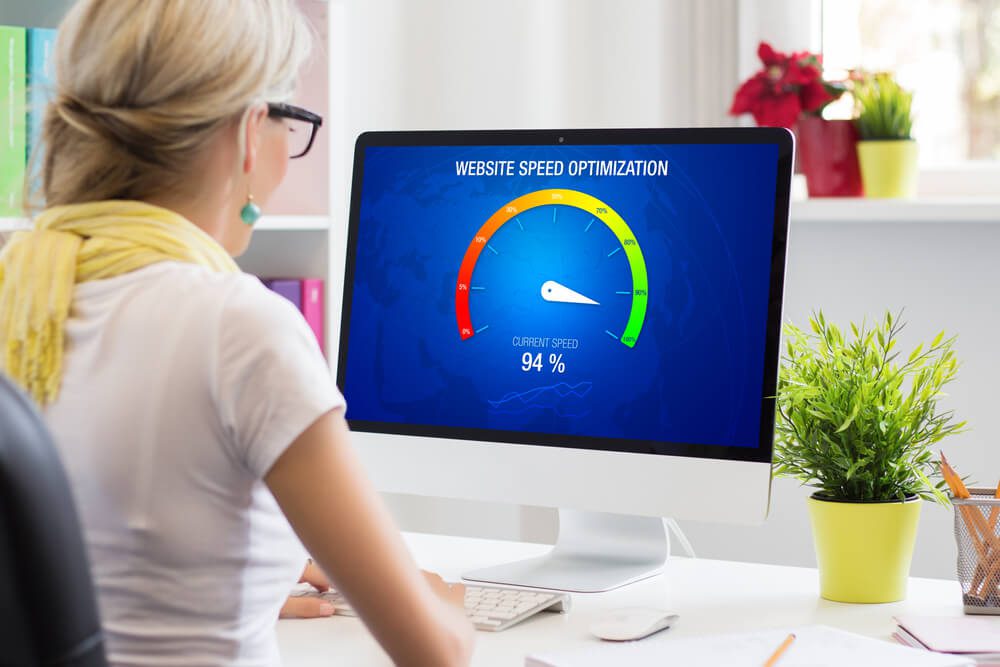
Turbocharge Site Speed for Your Enterprise Website and Watch SEO Rise
Page speed matters. It is a crucial part of your website experience, and it becomes even more crucial once you do enterprise search engine optimization (SEO).
This article provides a detailed explanation of how to make page speed a part of your strategy:
- Definition of page speed and its importance to growing websites
- Common reasons that speed declines, especially for enterprises
- Underrated optimization strategies to improve your numbers
Enterprise sites demand a modified SEO plan to attract targeted traffic and increase engagement and brand awareness. Read below to learn how to use page speed to achieve these goals. Let’s go!
Want to learn more about the Digital Authority Partners approach to SEO? Watch this video!
What Is Page Speed?

Page speed is the time it takes for a page to display all its content on a device. It is sometimes called download speed and is expressed in seconds. This term differs from browsing or internet speed, which is how long data moves from the server to the router.
Page speed is vital for enterprise SEO because it is a ranking factor; it affects your site’s position in the search results. Search engine bots can better crawl and index pages when the site is fast.
Page speed is also a common element of user experience (UX), another ranking factor. Slow loading times often increase bounce rates and lead to fewer pages per user session. It also degrades UX by interrupting consumption, leading to site abandonment. Meanwhile, quick page loads encourage users to consume more content.
Enterprise sites need good download speeds for the following reasons:
- Enterprise sites maintain hundreds of pages with several images, videos, scripts, and styles to load and render. Even marginal speed gains per asset add up.
- Growing websites see an increase in visitor volume. Shaving a few hundred milliseconds of load time saves significant cumulative bandwidth and computing costs.
- Corporate sites run on complex technology stacks with many third-party tools.
- A huge percentage of global traffic is mobile, where slow loads hurt even more.
- Slow sites mean losing customers to faster competitors, especially for big brands.
- Users expect speed from major companies, so lagging performance damages brand reputation and trust.
Lastly, page speed influences conversion, sales, and returns. Every second counts toward improving your bottom line.
One study showed that ecommerce sites could double their revenue by decreasing their loading time by a second. A popular big-box retail chain also discovered that their conversions increased by 2% for every second they improved their site speed.
Why Does Your Page Speed Decline?
Poor optimization remains the top reason for a slower download time. The site might have the following:
- Large file sizes for media assets, such as photos and videos
- Several plugins or extensions
- Bloated code
- Non-cached elements
- More content
- Outdated technology stacks
- Improper site migration
- Too many sites or page redirects
- No mobile optimization
- Poor or lacking site security
In some cases, the reasons are beyond your control. Consider the internet speed.
A third-quarter 2023 Ooka report revealed that Illinois had the fastest mobile download speed at 110.08 megabits per second (Mbps). Alaska posted the slowest number at 30.07 Mbps.
It also shared that T-Mobile was the fastest provider during the same period, providing a download speed of 163.59 Mbps. These companies’ performance also varied when tested on a 5G network.
Page speed also depends on the device your leads use. One global survey cited that the average desktop download time is faster at 2.5 seconds compared to over 8 seconds on mobile.
Your hosting providers’ infrastructure and management also influence page speed. The website is likely to load improperly with overloaded servers and consistent downtimes. It also slows down when the server’s location is far from the user.
The good news is that experienced SEO agencies can still manage or enhance page speed even when the reasons go beyond your site’s performance and design.
5 Page Speed Tips for Enterprise SEO

The ideal page speed is three seconds or less. The time to first byte (TTFB), or the rate at which the browser receives the first-byte response after a server request, should be between 200 and 500 milliseconds, depending on whether content is dynamic or static.
These are challenging numbers to hit. How do you achieve them? Here are seven underrated page-speed optimization strategies:
1. Look into the Web Core Vitals
Many marketers and developers use PageSpeed Insights to know their download times. This nifty tool provides a score of up to 100. Getting 90 and above means that your site’s speed is optimal.
They also determine their Lighthouse Performance Score, which grades sites according to accessibility, SEO, and best practices.
Although these platforms are reliable, they are limited. For example, Lighthouse is ideal when testing sites in a controlled environment. PageSpeed Insights does not provide a complete picture of a website’s performance.
The best enterprise SEO agencies obtain a more holistic approach to page speed improvement by looking into the Web Core Vitals.
Web Core Vitals is a combination of three essential metrics using real-world user experience:
| Metric | What It Measures | Recommended Speed |
|---|---|---|
| The largest contentful paint | Determines the perceived load speed or the time from page load until the main content renders | 2.5 seconds or less |
| First-input display | Measures interactivity or the time from when a user first interacts with a page (click, tap, etc.) to the response | 100 milliseconds or less |
| Cumulative layout shift | Assesses visual stability, which is the sum of all layout shift scores caused by elements shifting position as the page loads | 0.1 and below |
According to Google, 40% of the sites today pass the Web Core Vitals. They all contribute to helping save Chrome users around 10,000 years of download time.
There are many techniques that can be used to improve your page speed. One option is to prioritize content loading, especially with assets that should appear above the fold.
Suppose you are an ecommerce site. You can display the most important attributes first on a product page instead of the entire data.
Lazy loading is another method to improve page speed and meet the Web Core Vitals. It means that the site loads assets based on user needs. For example, images, videos, and iframes display dynamically when they should come into view during scrolling.
Optimizing these metrics requires advanced, customized techniques and in-depth data analysis. Hire a reputable SEO consultant to help you.
2. Scale Your Hosting Provider
Your server is crucial to your page speed, especially the TTFB. After all, it stores the assets the site should load or render.
However, your pages are stored with a hosting provider unless you build a solid IT infrastructure. This can cause problems, especially once you start scaling or growing.
Shared server spaces, for example, give you limited bandwidth that cannot handle increasing traffic and growing content. Some even cause the page speed to decline significantly during traffic spikes. Imagine you are an ecommerce site running a Black Friday sale. How many sales do you think you will lose because of this situation?
Some hosting providers run outdated infrastructure. The systems must be updated, leading to frequent downtime or 500 errors. Worse, this makes your site vulnerable to cyberattacks.
Your server space and hosting provider’s reliability should grow as your site expands. Assess your host based on these factors:
- Server hardware, such as SSD storage, modern processors, and enough RAM to provide faster hosting
- Network, such as bandwidth capacity, redundant servers, and fast interconnects
- Resources, such as storage, bandwidth, and computing power
- Caching options
- Monitoring tools
- Customer support
- Flexible plans
- Content delivery networks with global points of presence
Test the site's performance on your current host’s network. For example, use a Chrome developer tool called network throttling to determine how the frames load on a slow network connection.
3. Keep the Site Secure
Site security affects page speed. For example, a distributed denial-of-service (DDoS) attack overloads the server with fake requests. It exhausts resources and slows or takes down the site for legitimate users.
Further:
- Malware, such as computer viruses, consumes server resources. These include RAM, storage space, and CPU cycles.
- A breach might require taking a site offline or rebooting servers, causing downtime.
- HTTPS encryption and decryption processes increase the computing work required per request.
- Applying security updates and hardening servers requires rebooting and cycling services. These interrupt the site’s availability.
- Blocking and blacklisting malicious requests keeps them from reaching the site but might increase latency.
Security is a major ranking factor and a good UX signal. A good enterprise SEO team manages page speed and threats in other ways such as the following:
- Enabling caching of secure pages
- Applying edge computing
- Limiting security modules to only those needed
- Setting up a scaled DDoS mitigation policy for rate limits
- Managing exclusions for trusted bots, such as Googlebot, to avoid scanning delays
- Testing security tools regularly and adjusting settings to ensure optimal performance
- Updating all security platforms
- Limiting redirections by cleanly structuring URLs
- Matching server hardware to application needs and size for peak secure traffic
- Monitoring page speed before and after enabling security measures to quantify the strategy’s impact
Sites maintain robust security protections with minimal interference to high-speed page loads with proper implementation, planning, and testing.
4. Encourage Cross-Functional Collaboration
If you have performed every technical technique to improve speed and still need better results, look into your internal team. The reason might be your siloed departments.
A lack of cross-team collaboration indirectly affects page speed in many ways. Teams focus on their respective goals rather than shared business priorities and overlook download time. For example, if different departments upload copies to the site, it leads to a massive increase in content.
Additionally, departments working toward divergent goals often undermine or work against performance initiatives. No team sees the complete picture across infrastructure, apps, and networks that influence speed. Instead, they double up on work rather than build on each other’s efforts and tools.
Unintegrated testing also leads to performance regressions not caught pre-launch, while diffused responsibility means no team becomes accountable for site speed problems.
The simplest solution is to appoint a gatekeeper. It can be a specific person or a core team that designs and maintains the website. Other helpful ideas include the following:
- Design centralized platforms and tools for collaboration, communication, and visibility across groups.
- Schedule regular speed-focused working sessions with development, operations, marketing, and other stakeholders.
- Create a culture focused on end-user experience that aligns groups behind performance.
- Develop coordinated roadmaps, factoring in the needs of all teams and dependencies.
- Document processes and workflow across teams to identify gaps.
- Provide access to performance data and insights equally across the organization.
- Involve other teams early in launches, updates, and initiatives affecting speed.
Proactively building speed-focused alignment, communication, and transparency across teams sustains optimization efforts throughout growth.
5. Collect User Feedback
Users remain the best page-speed arbiters. It does not matter if you meet the Web Core Vitals criteria. They will abandon the page if they believe it is not fast enough.
On the other hand, they engage with websites that meet UX design principles. The pages are simple, accessible, helpful, and functional. In other words, the site satisfies their needs.
Use these tips to help you collect accurate, relevant user feedback on your download speed:
- Ask directly about site-speed satisfaction through surveys on the site or via email.
- Observe real users interacting with the site and note comments on speed.
- Monitor support or feedback channels for complaints on speed.
- Use session replays to capture speed struggles.
- Perform A/B testing to isolate possible download-time issues.
- Include easy page feedback buttons or links to report accessibility or usability problems.
Listening to real user comments provides the most accurate picture of speed perceptions. Combining multiple methods ensures complete coverage.
Summing Up
Page speed is only one step to overall UX and business goals. However, a faster downloading time offers tangible benefits. These include better engagement metrics, increased conversion rates, lower bounce rates, and improved SEO.
Do you need help increasing your page speed? Work with an award-winning enterprise SEO agency. Contact Digital Authority Partners to schedule a free consultation.
Want To Meet Our Expert Team?
Book a meeting directly here




